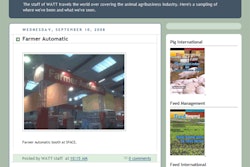If states are not ready to enforce new Confined Animal Feeding Operation (CAFO) permit rules, expect pressure on the U.S. Environmental Protection Agency (EPA) to push the deadline back, but livestock and poultry producers should not count on that.
“The deadline is Feb. 27, 2009 for producers seeking a permit to submit applications and expect EPA to not push the deadline back,” Thomas Hebert, vice president of Ogilvy Government Relations, said at the “Future of Environmental Rules for Animal Agriculture” webinar. The event,” sponsored by WATT’s EcoAgri.Biz, can be viewed here. EPA, Hebert said, “will leave the decision to the next administration.”
Based on what’s known as the “Waterkeeper” U.S. District Court ruling in 2005, producers have the option on whether to obtain a permit. But producers opting not to obtain a permit must be certain their operations do not discharge or they will be liable for stiff penalties, Hebert said. Operations with permits also cannot discharge except during what’s called a 25-year, 24-hour storm, but operations without permits would still be liable during such events, such as this spring’s severe rains in the Midwest. In EPA’s view, Hebert said, producers without permits would be liable for up to $32,500 in penalties per day from Feb. 27, 2009 each day until the date of the discharge. Thus, if an operation discharges in February 2010, fines could total $11.9 million.
Permitted operations, Hebert said, must provide their nutrient management plans for public review, and will have to deal with the potential for “paperwork violations.” Non-permitted operations, on the other hand, will not have their plans made public, but still must have a nutrient management plan, and must be certain they will never discharge.
Before making a decision on whether or not to seek a permit, Hebert advises producers to “spend time with an expert and your lawyer.” Hebert added that if an operation is a CAFO, manure stacked outside in a field “must be covered or surrounded with a berm because if it comes into contact with rainwater that flows to a surface water, it’s considered in violation of no discharge.”
Hebert said that if the manure from a livestock operation is transferred to a third party, a producer must test its nutrient content, but once the transfer is made, the livestock producer is no longer responsible for it.
Hebert said that efforts of livestock groups to have manure classified as a nutrient rather than hazardous material under federal superfund laws are not likely to be successful in Congress. EPA has proposed, however, to exempt ammonia gas from superfund reporting requirements. Hebert expects that to be challenged, however. Final rulemaking, he said, “is yet to be seen.”
On air quality, livestock producers are not regulated except in California and a few select air sheds, “but we will need to get to know the Clean Air Act better,” he said. At issue will be ammonia’s potential contribution to as a precursor to ozone or smog. No state has yet made the connection between ammonia and ozone, but one could in the future, he said. Ammonia’s contribution to total reactive or biologically action nitrogen is heavily regulated in Europe, and EPA’s science board is looking at it. “This is a long way from a real proposal, but it has some teeth behind it. This is something we should be very concerned about.”
Hebert noted that the U.S. Supreme Court directed EPA in 2007 to regulate greenhouse gas under the Clean Air Act, and EPA has issued a 588-page proposal. The agency said it is “bad policy” for it to use the Clean Air Act to regulate greenhouse gas, thus that “throws the issue back to Congress,” Hebert said. There will not be any action on greenhouse gas in Congress until next year, he said.
One major cap and trade carbon emissions proposal is the Lieberman-Warner bill, Hebert noted, which exempts agriculture from regulation, in fact “treats us as a source of credits—potential revenue.” According to the EPA, agriculture is responsible for 6.4 percent of all greenhouse gasses. Livestock operations have the potential to reduce methane through feeding and manure management strategies.
Hebert said that political experts predict that Democrats will win more seats in Congress this November, but that does not automatically mean a greenhouse gas bill will pass in 2009-10. The reason why, he said, is that such a bill would increase energy costs and that may not be very popular with the country “at the edge of a recession.”
The 2008 farm bill has several features of benefit to livestock producers, Hebert said. First, Congress authorized $3.4 billion for the Environmental Quality Incentives Program (EQIP), 60 percent of which is allocated to animal agriculture. EQIP funds can be used, in part, for environmental compliance measures. In addition, the Rural Energy for America Program is funded at $250 million and can be used to help livestock producers turn animal waste into energy through methane digesters and other means.
Hebert noted that both Sens. John McCain and Barack Obama support climate change legislation, but that it’s difficult to know how they would regulate CAFOs. On ethanol, he noted, McCain has opposed ethanol subsidies, while Obama has supported them. Regardless of who is elected president in November, “I worry that the country does not understand livestock and poultry production.”
















